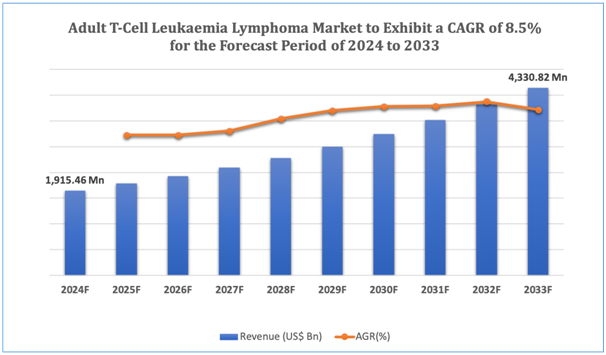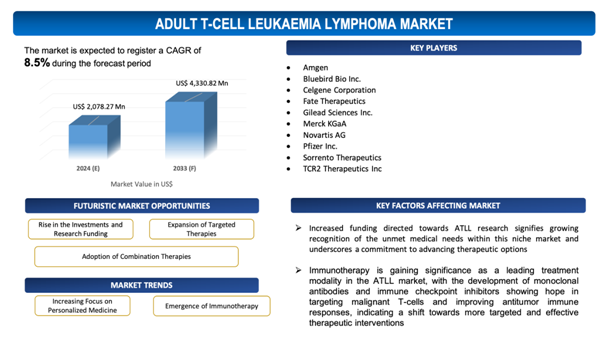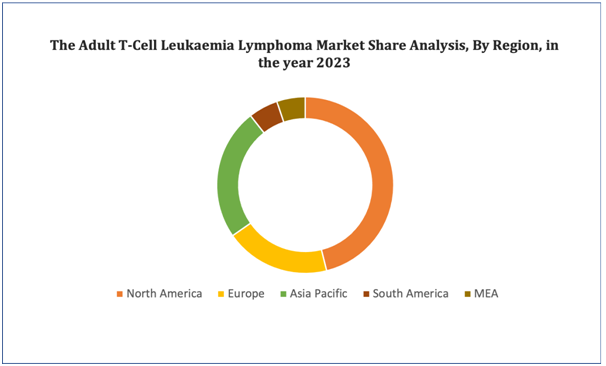Adult T-Cell Leukemia Lymphoma Market Overview
The global Adult T-Cell Leukemia Lymphoma market is estimated to be worth over USD 4,330.82 Mn in 2033 and is expected to grow at CAGR of 8.5% during the forecast period (2024-2033).
Adult T-cell leukemia-lymphoma (ATLL) represent as a rare and hostile form of cancer, arising from the infection of mature T lymphocytes with the human T-cell lymphotropic virus type 1 (HTLV-1). This malignancy chiefly affects adults and manifests through a range of clinical symptoms, comprising skin lesions, hepatosplenomegaly, lymphadenopathy, and hypercalcemia. Categorized into four distinct subtypes - chronic, acute, lymphoma, and smouldering - ATLL exhibitsdiverse prognoses and needspersonalized treatment approaches. Despite its rarity, the global market for ATLL treatment indicatessoaring attention owing to escalated recognition of HTLV-1 infection as a worldwide health concern, specificallycommon in regions like the Caribbean, Japan, and parts of Central Africa where the virus is indigenous.
Traditional therapeutic strategies for ATLL includeantiretroviral therapy, chemotherapy, and hematopoietic stem cell transplantation. Despite that, these interventions oftentimes yield confined success, with lesser overall survival rates. Nevertheless, latestbreakthroughs in immunotherapy and targeted therapies offer commitment in redefining the treatment panorama for ATLL. The market for ATLL is also influenced by initiatives emphasized on raising awareness about HTLV-1 infection and its association with ATLL, thereby bolstering demand for improved diagnostic tools and therapeutic interventions.
Regardless ofthe challenges springing from its rarity and limited treatment alternatives, continuing research endeavors aimed at untangling the pathogenesis of ATLL and determining novel therapeutic targets are poised to fuel market expansion. Furthermore, collaborations between academia, pharmaceutical organizations, and regulatory bodies hold a crucial role in advancing clinical development efforts and expediting the translation of scientific discoveries into effective treatments. Since understanding of HTLV-1 infection and ATLL continues to deepen, along with advancements in precision medicine and immunotherapy, the global market for ATLL is estimated to experience gradual growth, ultimately improving outcomes for individuals grappling with this arduous disease.
Figure 1. Adult T-Cell Leukemia Lymphoma: Market Size

Get more details on this report - Request Free Sample
Key Market Insights &Current Market Landscape:
The global Adult T-cell leukemia-lymphoma (ATLL) market presents a specializedoutlook marked by its peculiarity and the complicated nature of its treatment. Significant insights underscore an urgent need for advanced therapeutic approaches owing to the limited efficiency of traditional treatments such as chemotherapy and stem cell transplantation. Major developments in the market have aimed their focus on exploring novel technologies and targeted therapies to address this unmet medical need. Immunotherapy, especially monoclonal antibodies targeting specific antigens on malignant T-cells, has surfaced as a promising avenue for ATLL treatment. In addition to that, innovations in precision medicine and genetic profiling are promoting the development of personalized therapeutic strategies personalized to individual patients. Regardless of these advancements, challenges continue in terms of market access and affordability of novel therapies, particularly in regions where ATLL is endemic. Along with that, regulatory hurdles and limited awareness about HTLV-1 infection and its association with ATLL pose additional barriers to market growth. Nonetheless, collaborations between industry stakeholders, research institutions, and regulatory agencies are fueling forward innovative research and clinical trials, fostering commitment for enhanced outcomes and expanded treatment alternatives in the global ATLL market.
Market Dynamics
Market Drivers
Rising Prevalence of Lymphoma and Leukemia
Since lymphomas and leukemias become more commonacross the globe, there is an equivalent rise in the number of patients potentially at risk of developing ATLL, specifically those infected with the human T-cell lymphotropic virus type 1 (HTLV-1). The Leukemia and Lymphoma Society states that 186,400 new cases of leukemia and lymphoma will be found in people living in the United States in the year 2021. In the United States, there were also 825,651 people living with lymphoma, 152,671 of who had Hodgkin lymphoma and 672,980 of whom had non-Hodgkin lymphoma.This escalated awareness of associated hematologic malignancies alerts healthcare providers to actively screen and monitor individuals with HTLV-1 infection, potentially leading to earlier detection and intervention for ATLL. In addition to that, breakthroughs in diagnostic techniques and enhanced understanding of HTLV-1 transmission contribute to the determination of high-risk populations, further fueling the demand for effective ATLL treatments.
Moreover, the sharp surge in the incidence of lymphoma and leukemia highlights the pressing need for advanced therapeutic approaches to address the intricate and aggressive nature of these diseases, offering opportunities for the development and commercialization of novel drugs and targeted therapies within the ATLL market. Overall, the growing prevalence of lymphoma and leukemia globallyholdsan integral role in defining the growth trajectory of the global ATLL market, propelling investment in research, development, and healthcare infrastructure to meet the evolving needs of affected individuals.
Market Restraints
With regard to numerous advantages of Adult T-Cell Leukemia Lymphoma, the market faces several challenges due to the unique characteristics and requirements associated with them. Some of the key market challenges include:
- Limited Treatment Options: The global ATLL market struggles with a lack of effective treatment modalities, limiting therapeutic choices and hampering the attainment of favourable outcomes, specifically in advanced disease stages. The scarcity of approved therapies not only hinders patient management but also worsens the burden on healthcare systems, leaving clinicians with few options to address the complicated nature of ATLL.
- Regulatory Challenges: The ATLL market encounters hurdles springing from stringent regulatory frameworks and complicated approval processes for novel therapies. These obstacles prolong the time-to-market for innovative treatments, imposing substantial delays and financial strains on pharmaceutical firms seeking to introduce new drugs, thereby impeding market growth and limiting access to potentially beneficial interventions for ATLL patients.
Market Opportunities
Rise in the Investments and Research Funding
Increased funding directed towards ATLL research signifies growing recognition of the unmet medical needs within this niche market and underscores a commitment to advancing therapeutic options. With greater financial support, researchers can delve deeper into understanding the underlying mechanisms of ATLL pathogenesis and determining novel therapeutic targets. In addition to that, investments support the development of innovative treatment modalities, including targeted therapies and immunotherapies, which have the potential to revolutionize ATLL management. Furthermore, heightened research activity fosters collaborations between academia, pharmaceutical companies, and regulatory bodies, supporting the transcription of scientific discoveries into clinical practice. These partnerships accelerate the development and commercialization of promising drug candidates, thereby expanding the treatment armamentarium available to ATLL patients. Overall, the surge in investments and research funding not only fuels forward scientific advancements but also accelerates market growth by encouraging innovation and addressing the unmet needs of individuals afflicted with ATLL.
Market Trends
- Increasing Focus on Personalized Medicine: There is a soaring trend towards personalized medicine approaches within the global ATLL market, with advancements in genetic profiling and precision medicine techniques allowingpersonalized treatment strategies based on individual patient characteristics and disease profiles.
- Emergence of Immunotherapy: Immunotherapy is gaining significance as a leading treatment modality in the ATLL market, with the development of monoclonal antibodies and immune checkpoint inhibitors showing hope in targeting malignant T-cells and improving antitumor immune responses, indicating a shift towards more targeted and effective therapeutic interventions.

Get more details on this report - Request Free Sample
Adult T-Cell Leukemia Lymphoma Market: Key Segments
By Type
- Peripheral T- Cell Lymphoma
- Cutaneous T- cell Lymphoma
- Anaplastic large cell Lymphoma
- T- cell Prolymphocytic leukemia
- Others
By Treatment
- Chemotherapy
- Radiation
- Surgery
- Others
By Route of Administration
- Oral
- Parenteral
- Others
By Distribution Channel
- Hospital Pharmacy
- Retail Pharmacy
- Others
By End User
- Hospitals
- Specialty Clinics
- Others
By Key Geographical Regions
- North America
- Europe
- Asia-Pacific
- Middle East and Africa
- South America
Adult T-Cell Leukemia Lymphoma Market: Regional Analysis
North America dominates the thymus (T)-cell lymphoma treatment market in terms of market share and revenue and will continue to flourish its dominance during the forecast period. This is attributing to the presence of significant key players and well-developed healthcare infrastructure in this region.Asia-Pacific on the other hand is estimated to showcase the highest growth rate during the forecast period due to the increasing prevalence rate, rising investment in the healthcare sector and soaring government support.
Figure 4. Adult T-Cell Leukemia Lymphoma Market: Distribution by Region

Get more details on this report - Request Free Sample
Leading Adult T-Cell Leukemia Lymphoma Developers
Industry Trends and Global Forecasts, 2023-2035 report features an extensive study of the current market landscape, market size and future opportunities associated with the Adult T-Cell Leukemia Lymphomamarket, during the given forecast period. Further, the market report highlights the efforts of several stakeholders engaged in this rapidly emerging segment of the biopharmaceutical industry. Key takeaways of the Adult T-Cell Leukemia Lymphomamarket are briefly discussed below.
The report includes the list of players operating in the global Adult T-Cell Leukemia Lymphomamarket. Some of the key players include:
- Amgen
- Bluebird Bio Inc.
- Celgene Corporation
- Fate Therapeutics
- Gilead Sciences Inc.
- Merck KGaA
- Novartis AG
- Pfizer Inc.
- Sorrento Therapeutics
- TCR2 Therapeutics Inc
Recent Developments in the Adult T-Cell Leukemia LymphomaMarket
Several recent developments have taken place in the field of Adult T-Cell Leukemia Lymphoma, some of which have been outlined below. These developments, even if they took place post the release of our market report, substantiate the overall market trends that we’ve outlined in our analysis chronologically.
- In June 2022, Bristol Myers Squibb announced that the U.S. Food and Drug Administration (FDA) has approved Breyanzi® (lisocabtagene maraleucel), a CD19-directed chimeric antigen receptor (CAR) T cell therapy, for the treatment of adult patients with large B-cell lymphoma (LBCL), including diffuse large B-cell lymphoma (DLBCL) not otherwise specified (including DLBCL arising from indolent lymphoma), high-grade B-cell lymphoma, primary mediastinal large B-cell lymphoma, and follicular lymphoma grade 3B.
Scope of the Report
The market report presents an in-depth analysis of the various firms / organizations that are engaged in this market, across different segments, as defined in the below table:
|
Key Report Attributes |
Details |
|
Base Year |
2023 |
|
Forecast Period |
2024-2033 |
|
CAGR (2024-2033) |
8.5% |
|
Type |
|
|
Treatment |
|
|
Route of Administration |
|
|
Distribution Channel |
|
|
End User |
|
|
Key Geographical Regions |
|
|
Key Companies Profiled |
|
